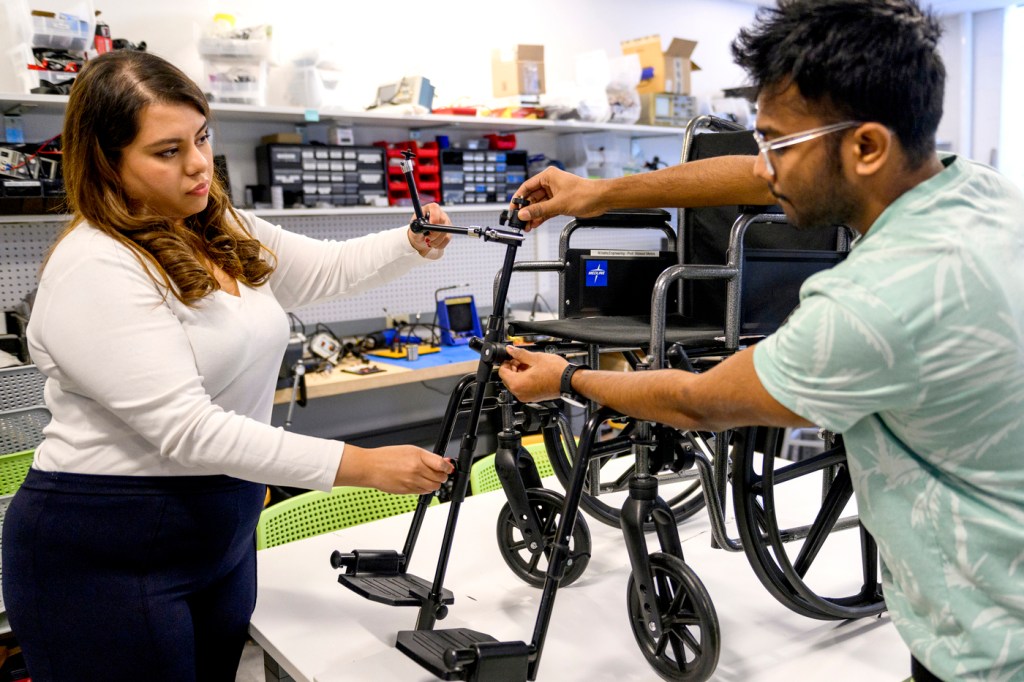Engineers develop tool to treat femoral hematomas and improve wheelchair camera mount with the help of high school students

A femoral hematoma is not a typical problem for a high schooler. In fact, identifying and treating such a serious bruise can give even health care professionals trouble.
Nor is a high schooler typically focused on how to keep a camera steady for filming while using a wheelchair.
But these challenges were on the minds of high school students who took part in the Enabling Engineering internship program this summer at Northeastern University.
“You took our ideas and what you presented was what we hoped, what we imagined — in fact, it was even better than we hoped,” Deirdre Hamilton, a nurse at Boston’s Brigham and Women’s Hospital, told the team of students who developed a training tool to correctly identify and treat femoral hematomas.
Enabling Engineering is a Northeastern student-led group that designs and builds devices to empower individuals with physical and cognitive disabilities. This summer, the group collaborated with For Inspiration and Recognition of Science and Technology (FIRST) — a global robotics community preparing young people for the future — to offer a seven-week internship program.
Students from Newton, Massachusetts, worked on two projects.
The first team — Franklin Ji, Dennis Liu and Chloe Kwan — improved upon the stability, adjustability and accessibility of a wheelchair camera mount that NU students designed over the spring 2023 semester in collaboration with a filmmaker in Malawi with the Disability Justice Project who uses a wheelchair.
“There is more stability, more rotation and it is easier to adjust, as well as more versatile,” Kwan said.
The team also made the roughly $90 mount smaller when broken down in pieces, which made it much less expensive to ship.
“It’s exciting, I feel like we’re much closer” to a final product, said Jody Santos, executive director of the nonprofit, which trains people with disabilities from the Global South in documentary storytelling.
A second team tackled the hematoma conundrum, with Brigham and Women’s Hospital nurses Hamilton and Laurie Demeule as clients.
The team members explained that cardiac catheterizations through the pelvic region can develop hematomas or painful and serious bruises where blood collects and pools beneath the skin. The team described the feeling as like a golf ball was underneath the skin and, indeed, the teaching model for identifying hematomas currently involves a stress ball over a golf ball or a marble.
But that teaching model needs improvement, as it is neither detailed nor adjustable. Also, since most cardiac catheterizations are now through the wrist, nurses don’t often get taught how to identify femoral hematoma. Moreover, they don’t know how to apply appropriate pressure to treat such a bruise.
So, the team designed a pelvic model that mimics the feel of a femoral hematoma for identification and evaluates the pressure applied that is necessary for treatment. It does this using an inflatable bladder of water balloons to simulate the hematoma. Pressure sensors above and below the simulated hematomas will detect whether the trainee is correctly applying pressure to stop the blood flow and to allow diffusion — a green light meaning the correct pressure is being applied, and a red light meaning an incorrect amount of pressure.
The project had to cost less than $500 and be completed in the seven-week timeframe. The final cost was $326.05.
Hematoma team member Isabella Tang,18, who just graduated from Newton North, said that it was also important that the product be easy and inexpensive to fix and have readily available components.
“Water balloons are such an easy, simple and cheap way to do this,” Tang said.
Not that there wasn’t some nervousness with the tight deadline.
“It took a lot of hoping and praying that it would work well because we had one shot,” said Aaron Paker, 15, of Newton North.
Waleed Meleis, faculty adviser and founder of Enabling Engineering, congratulated the students, Brigham and Women’s Hospital, the Disability Justice Project, and FIRST robotics for coming together in this “exciting” collaboration.
“To bring the collaboration to life has brought Northeastern and the program a lot of exposure to a wide range of students taking part in FIRST robotics,” Meleis said. “This is a huge achievement for our organization, the College of Engineering and Northeastern.”
Meanwhile, Priyanka Jalan, faculty and program manager at Enabling Engineering, said that both projects “finished on time and on budget, and achieved the mission of Enabling Engineering.”
“That’s what every company wants to hear,” said Greer Tan Swiston of FIRST and a coach for the robotics team at the Newton high schools. “They’ve innovated, made a huge impact in the community and they’ll take that with them — it was a wonderful experience.”
Nurse Laurie Demeule agreed, noting that “many, many” nurses would benefit from the training tool.
You’ve made a difference, please know this and walk proud,” Demeule told the students. “You’ve given me faith for the future.”
Cyrus Moulton is a Northeastern Global News reporter. Email him at c.moulton@northeastern.edu. Follow him on Twitter@MoultonCyrus.






